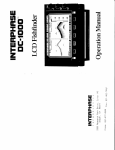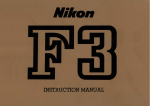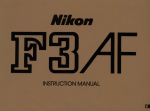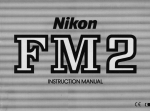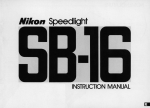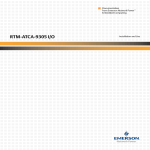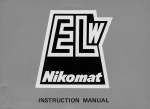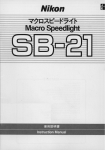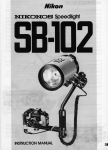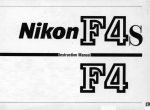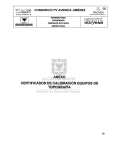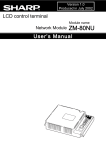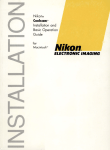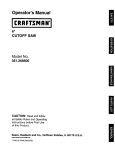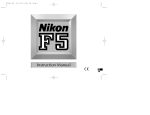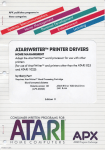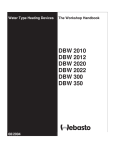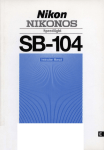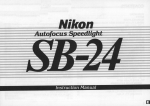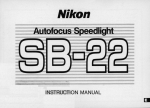Download Nikon FG Camera FG User's Manual
Transcript
Nikon
INSTRUCTION MANUAL
J
Film advance lever
.~
Al P setting lock button
~•. Shutter speedl mode selector
4 Neckstrap eyelet
5. Hand grip
6 Self -timer lever
7 Reflex mirror
8 Lens aperture scale
9 Distance scale
10 Depth-of -field indicators
11 Aperture / distance scale index
2
Exposure compensation dial lock @
Exposure compensation dial 1-3)
Exposure compensation dial index lj)
Exposure compensation
button ~)
Meter coupling lever (f_6~
Lens mounting index
lJ~
Lens release button 'I§;
Infrared focusing index Q9/
Lens aperture ring 1211;
Lens mounting ring (2J;
Lens focusing ring
(n
n Hot-shoe contact
Shutter release button ®
21' Acc essory shoe
Audio warning lever @
2§ Film rewind crank
Frame counter @
2§ Film rewind knob
2't ASAIISO
Film plane indicator @
film speed index
Film takeup spool @
28-Film rewind fork
)~ASA / ISO
Film pressure plate @
film speed dial
Film sprocket @
'3d Film cartridge chamber
Data back contacts (f4;
3-1 Shutter curtains
Memo holder @
JZ Film guide rails
Camera back @
~J' Viewfinder eyepiece
34 Film rewind button
Tripod / motor drive coupling socket @
35 Motor drive coupling
3g Motor drive positioning
hole
~.
~
'
Motor drive electrical contacts @
?A
~":,:.-
r' ''''
•
I
~
~~==i=
- "=
'~ ~,.. .. e.. .~~~~
Battery chamber lid/battery clip @
3
NOMENCLATURE . .......................... 2
FOREWORD .. .............................. 5
BASIC OPERATION . ........................ 6
NIKON AND NIKKOR LENSES
FOR THE NIKON FG ....................... 19
CONTROLS IN DETAIL . .................... 20
Shutter Speed! Mode Selector Dial. ......... 20
Exposure Measuring System ............... 21
LED Viewfinder Indications ................ 22
Exposure information .................. 22
Improper exposure warning information . . 23
Flash ready-light information ........... 23
How To Determine Shooting Modes......... 24
P- programmed exposure mode ....... 24
A-automatic exposure mode .......... 28
Manual exposure mode ................ 35
Shutter Release Button ................... 38
Film Advance Lever ....................... 39
Frame Counter. .......................... 39
Audio Warning Lever ...................... 40
ASAIISO Film Speed DiaL ............. '" . 41
Exposure Compensation Dial .............. 42
Exposure Compensation Button ......... " 43
Self-Timer Lever .......................... 44
Film Plane Indicator ...................... 44
Handgrip ................................ 45
Memo Holder ............................ 46
Infrared Focusing Index ................... 46
4
FLASH PHOTOGRAPHy .................... 47
Accessory Shoe . ......................... 48
Viewfinder Ready-Light. .................. 48
Nikon FG and Speedlight Combinations .... 49
CLOSE·UP PHOTOGRAPHY . ............... 50
ACCESSORIES . ........................... 52
Electronic Flash Units ..................... 52
Motor Drive MD-14 ........................ 53
Data Back MF-15 ......................... 54
Other Accessories ........................ 55
TIPS ON CAMERA CARE . .................. 58
OPTIMUM BATTERY PERFORMANCE . ..... 59
SPECIFICATIONS .......................... 60
IMPORTANT . .............................. 63
As Nikon's selective-exposure 35mm SLR camera,
the Nikon FG gives you the choices not only of totalexposure programming but also aperture-priority
automatic exposure as well as full manual control.
Compact and lightweight, the FG additionally offers
such advanced photographic features as an exposure compensation dial, an exposure compensation
button and an audio warning system, plus its own
matching electronic flash with TTL measurement,
automatic motor drive and automatic data back.
And of course with the FG, you've full admission
into the comprehensive Nikon System of over sixty
interchangeable lenses and a host of accessories
and equipment. To get the most out of your FG,
study the instructions in this manual carefully. Every
basic operation and all controls and features are
explained in detail. Practise using your FG without
film until you are familiar with the simple operating
instructions, then keep this manual on hand for
ready reference. A few minutes now is your assurance of the best future results as you enter the
exciting world of selective-exposure photography
with the Nikon FG.
5
Use a cO in to twi st the lid cou nter cloc kwi se to unsc rew it
Wipe battery terminals clean an d
insert either one 3V lithium battery,
two 1.SSV silver-oxide batteries ,
or two 1 SV alkaline manganese
batte ries into the battery clip,
making sure each" + " sign is up
Caution: Keep batteries away from infants and small children In case a bat
tery is accidentally swallowed, call a
doctor immediately as the material in
side the batteries can cause serious
problems
6
Slip the battery clip back into the
camera body and screw it c lockwise tightly in place .
Looking through the vi ewfinder 33. , depress the
shutter release button 37 halfway and confirm that
any of the red LED s (l ight emitting diodes) light up
steadily or blink continuous ly for 16 seconds after
you have taken your finger off the button . This means
battery installati on is proper and power IS sufficient
If no LEDs light up or if they turn off immediately when
you take your finger off th e bulton , re place the
battery (ies)
Grasp the lens by its mounting ring , then line up
the aperture/distance scale index lion the lens and
the mounting index 17 on the ca mera body and twi st
the lens cou nterclockwise until it cl icks into place.
Make sure the apertur e/d istance sca le index is
exa ctly orl top
To remove , while pushing the lens release button 18
turn the iens clockwise
Note: To check battery powe r, set the shutter speed/mode
selector dial 3 to any se tting except M90 and B
7
Pull up the film rewind knob 26 as
far as It will go and the camera
back will pop open .
Drop the film cartridge into
the film cartridge chamber ,10. so
the film leader pOints towards the
takeup spool .41, and while rotating
the rewind knob push It back down
to secure the cartridge in place
Notes:
1) AI135mm film can be used
2) Avoid loading film In direct sunlight
If there is no shade available. turn
your back to the sun and use your
own shadow to shield the camera
8
Pull the leader across the camera
and insert it into anyone of the
slots in the takeup spool
Advanc e the tak eup spool slightly with your finger to
engage th e film' s perfo rati on s with the teeth of th e
ta keu p spool and th e sp roc ket 43 Confirm th e film is
loca ted properly between both guide rail s nand
tha t ther e is no film slack
Altern ately wind the film advance leve r and depres s
the shutter release button until the perforations on
both film edges are sec urely engaged with the
sprocket teeth and th e film is adva nced properly
9
Snap the camera back shu1.
10
Fold out the film rewind crank 25 and rotate
it gently in the direction of the arrow until you leel a
slight resistance . Then fold the crank back in
To dispose of the first few frames exposed during film
loading continue to alterna tely advance the tilm and
dep ress the shu tter re lease button until the frame
count er shows "1 ' Check th at the rewind knob IS
rotatin g, indi ca ting the film has been loaded correctly
and IS being advanced If the knob does not rotate.
re load the fi lm
Lif t up the ASAIISO film speed dial and rota te it in
either direction until the index dot is opposite the film
speed in use . Make sure the exposu re compensation
dial is se t at "0 .. These actions are essential to acti ·
vate the camera's exposure meter for correct exposu re of the film being used .
Note: Film speed is printed on the film package and cartridge.
Note: 00 not take pictures prior to frame ., 1 .. as the meter
does not funcflon until the counter reaches '1" Up to "1 ,"
the 1/60 and 11125 sec LEOs in the viewfinder will blink.
showing the shutter is automatically set at 1/90 sec
11
Wh ile depre ssing the Al P setting loc k button (2 . turn
th e srlut te r sp eed/ mode sel ec tor until P is opp os ite
[fI e Index The bU ilt -In loc king mec hanisms at P and A
en su re trla t th e di al ca rmot be ac c identally shifted
tram eltrl er- the P or A pos it ion dur ing shoot ing
Note : Tfl e Nikon FG ca mera tlas t wo m ore shoaling modes
oeslde s P (Prog ram) A (Au to ) and m anua l For details of
st-;ootlng "I tn c:"e moUes ,see ;Jage0 28,v3,1 fo r A (Au to ) and
[JdJ8 " 35, v 37 tor manua l
il
Turn the ape rture ring of the lens until the la rgest f l
numbe r IS opposite the ape rture index, If the apertur e
IS not set to t111 o r larg e r, both warning LED s in the
viewfinder w ill blink altern atel y, warnin g of imprope r
setti ng
,
Turn the lever as far as it will go, uncovering the audio
warning mark ( "J) ).
Fold out the film advance lever to the stand·
off position. With your right hand grasping the hand·
grip (5) steadily and your right index finger resting
comfortably on the shutter release button, position
your right thumb between the camera body and the
lever. Then cradle the camera in the left hand with the
thumb and fingers holding the lens focusing ring The
camera may be switched from horizontal· to vertical·
format shooting in this position
13
While looking through the viewfinder, compose your
photo with the main subject in the center to assure
correct exposure . Then turn the focusing ring @ of
the lens until the subject looks clear. The FG employs
the standard Type K focusing screen for all-purpose
photography. For precise pinpoint focusing for subjects with distinct contours, use the central splitimage rangefinder and turn the focusing ring until the
split image becomes whole. For rapid focusing and
for subjects with indistinct outlines, use the micro-
14
prism collar and turn the focusing ring until the shimmering image becomes sharp. When doing close-ups
or macrophotography or shooting with telephoto
lenses of maximum apertures of approx . f/4 .5 or
smaller, the split-image spot and microprism collar
are likely to darken. Therefore, use the matte outer
field and turn the focusing ring until the image becomes sharp .
6
5
1 23 4
1. 3mm dia. split-image spot
2. 1 mm-wide microprism collar
3. 12mm dia. area
4. Fine matte/ Fresnel outer field
5. Shutter speed scale
6. Top warning LED
7. Shutter speed LEDs
8. Bottom warning LED
9. Flash ready-light
10. Thunderbolt mark
7
8
9
10
Notes:
1) The meter reads the light over the
en tire focusing screen but is dis ·
tin ctly biased to ward the central
12mm dia area.
2) Frame coverage is approx 92 %
which means actual photographs will
be slightly larger than the finder image
15
Look through the viewfinder and press the shutter release
button halfway to turn on the exposure meter. When the audio warning
does not sound. depress the button all the way to take the picture. In this
case, the proper shutter speed to match scene brightness It displayed
by the LED Inside the viewfinder. If the warning sounds, check the viewfinder Information . If either the top or bottom warning LED blinks, the
available light is too bright or too dim for the meter's range and correct
exposure is not possible without adjustment. Use either a neutral density
filter to reduce the amount of light reaching the film or artificial light to
increase the subject's brightness If the LED at 1/30 sec or below lights
up. shutter speed is too slow and blur may result . In this case, use a
tripod to prevent blurred images . When you correct the exposure, the
audio warning will stop
16
Stroke the film advance
lever to transport the film to the
next frame .
After the last exposure, the film advance lever will not
move Depress the film rewind button on the camera
base plate to disengage the film sprocket drive so
you can rewind the exposed film back into its cartridge .
Fold out the film rewind crank and turn it
gently in the direction of the arrow until you feel an
increased tension . Give it a few more turns until the
tension is gone and the crank turns freely. indicating
the film leader is rewound completely back into the
cartridge .
17
Open the camera back by pulling up the
rewind knoll and take out the film cartridge . Avoid
unloading in direct sunlight If there is no shade
available, turn your back to the sun and use your own
shadow to sh ield the camera
18
The lenses usable for the Nikon FG are all the AI-type
Nikon/Nikkor lenses, including most of the AI converted lenses, certain Reflex Nikkor and PC Nikkor
lenses. Non-AI Nikkor lenses and lenses of other
manufacturers which do not have the AI feature must
not be forcibly mounted on the FG. Attempts to mount
such lenses will damage the camera's indexing
mechanism. Note that in addition to non-AI lenses
the following lenses cannot be used:
'
AI-converted 55mm f/1.2 (No. 184711 "-'970110)
AI-converted 28mm f/3.5 (No. 625611,,-,999999)
AI-converted 35mm f/1.4 (No. 385001 "-'400000)
Fisheye Nikkor 6mm f/5.6 (all lenses)
Fisheye Nikkor lOmm f/5.6 OP (all lenses)
Reflex Nikkor 1000mm f/11 (No. 143000 or smaller)
Reflex Nikkor 2000mm f/11(No. 200310 or smaller)
PC Nikkor 28mm f/4 (No. 180900 or smaller)
PC Nikkor 35mm f/2.8 (No. 851001"-'906200)
Zoom Nikkor 180,,-,600mm fl8 ED
(No. 174180 or smaller)
Zoom Nikkor 200"-'600mm f/9.5
(No. 301922 or smaller)
Zoom Nikkor 360"-'1200 mm f/11 ED
(No. 174127 or smaller)
Focusing Unit AU-1
When using the Teleconverter
TC·200, TC·201, TC·301 or
TC·14A
Exposure compensation, which is required
when using Nikon AI-type cameras with lenses
having a maximum aperture faster than f/2 or
faster than f/1.8 (when using the TC-14A), is
not necessary when using the FG in its P or A
mode. In the A mode, however, note that the
actual shutter speed will be faster than that
indicated in the viewfinder by less than one
step. Therefore, before shooting, be sure that
the shutter speed LED(s) in the viewfinder
indicates a speed slower than 1/250 sec. In
the manual mode, exposure compensation
using the ASA/ISO film speed dial is necessary.
See the teleconverter's instruction manual for
complete details.
19
from 1 to 1/1000 sec, A and P Intermediate settings
cannot be used.
P (Programmed)
Used for completely automatic programmed mode
shooting. The optimum combination of shutter speed
and aperture value is automatically set by the FG 's
microcomputer, depending upon scene brightness
and the film speed in use. The electronically controlled
shutter speed is stepless between 1 and 1/1000 sec.
A (Auto)
The Nikon FG offers programmed mode operation,
aperture'prlority automatic mode operation, and
manual control of all shutter speeds from 1 to 1/1000
sec, including M90 and B (Bulb) settings. To set the
desired shooting mode or shutter speed, rotate the
shutter speed 1m ode selector dial until the desired
setting click·stops opposite the index line. Note that
at A and P settings, a locking mechanism is provided
to prevent accidental shifts of the setting . To rotate
the dial to or from the A or P setting, depress the lock
button 2, provided The shutter speed/mode selector
dia l has the follOWing settings B, M90, eleven speeds
20
Used for aperture'prlority automatic mode shooting.
The f/stop is set manually and the FG's microcom·
puter selects the matching electronically controlled
shutter speeds steplessly between 1 and 1/1000 sec.
depending on the scene's brightness and the film
speed in use .
Manual
Used for full manual control of both f/stop and shutter
speed . All of the eleven shutter speeds indicated on
the dial are electronically set, With accuracy assured
by a quartz oscillator controlling shutter timing . Each
number shown on the scale is reciprocal, i.e .. 2
means 1/2 second, and 125 means 1/125 second . A
one·step change will either halve or double the expo·
sure, e.g., a shutter speed of 1/125 sec . lets in twice
as much light as a setting of 1/250 sec ., and half as
much light as 1/60 sec.
Note: When you set the shutter speed/mode selector dial to
either M90 or B, the exposure meter does not work and the
viewfinder LEOs don't light.
M90 (1/90 sec.)
At this setting, the shutter operates mechanically at
1/90 sec., and is used mainly when the battery is
drained and other shutter speed modes are not
operable, and for flash photography with an electronic flash.
B (Bulb)
At this mechanical setting, the shutter curtains '$J
remain open as long as you press the shutter release
button. B is used for long time exposures.
Note: When the shutter speed/mode selector dial is set
somewhere between 1 sec. and M90 and the shutter release
button (f!, is accidentally depressed, the shutter curtains remain open. If the film is rewound in this situation, every frame
will be re-exposed, damaging the pictures taken. Therefore,
before rewinding make sure that the selector dial is not in this
intermediate position.
The Nikon FG employs TTL (through-the-Iens) centerweighted full-aperture exposure measurement which
measures the amount of light passing through the
lens with the aperture fully open, thus always assuring a bright finder image during shooting. Exposure
measurement emphasis is placed especially on the
brightness in the 12 mm dia. central area (refer to
page 15), although the meter reads the light over the
entire focusing screen. Thus, correct exposure is
assured when shooting with the main subject situated
in this central area.
On both P and A modes, the FG employs instantaneous stopped-down exposure measurement. This
measurement system sets the optimum combination
of shutter speed and aperture at the actual splitsecond moment of picture taking, assuring accurate
exposures even if the light changes at the very last
instant. A sensitive SPD (silicon photodiode) is used
to measure light intensity.
21
Exposure information
on P or A
on manual
Top warning LED
~~~ = Blinking LED
• = Steadily
lighting LED
Shutter speed LEDs
Bottom warning LED
Flash ready-light
Exposure information
Red LEDs (light emitting diodes) located opposite the
shutter speed scale at the right-hand side of the viewfinder light up when the shutter release button is
depressed halfway. These function in three capacities-for exposure information, for improper exposu re warning, and for convenient flash shooting.
22
On P or A, a steady LED indicates the shutter speed
automatically set. Two adjacent LEDs indicate set
speed is intermediate between the two. On manual ,
a steady LED indicates the shutter speed set manually
and the blinking LED(s) signals the correct speed to
match the selected aperture .
Notes:
1) At M90 and B, there is no LEO display.
2) Shutter speed selection is stepless on P and A, however
on manual, intermediate speeds cannot be set.
Possible
overexposure
Possible
underexposure
Shutter speed is
too slow
Improper exposure warning
information
On P or A, a blinking top warning LED indicates possible overexposure In this case, use a neutral density
filter or change to a slower speed film _ A blinking
lower warning LED signals possible underexposure,
necessitating an electronic flash or a change to the B
setting for long exposure. On P, A and manual, an LED
lighting at 1/30 sec or below indicates shutter speed
is too slow for hand-held shooting and a tripod is
necessary to steady the camera or a high-speed film
or electronic flash should be used .
Flash ready-light
Flash ready-light information
An LED opposite the thunderbolt mark enables you to
confirm flash readines s without removing your eye
from the viewfinder (3_3) ,
Note: When using a tripod with a large head, use Nikon 's
tripod adapter to mount the FG : otherwise contact between
lens barrel and head may make it difficult to operate the lens,
23
P-programmed exposure mode
Correct exposure-whether your photo comes out
just right and neither too dark (underexposed) nor too
light (overexposed)-depends on two factors in relation to your film: light and time. These factors are
controlled by f/stop (aperture opening) and shutter
speed. The FG offers three different ways (modes) to
expose photos-P (Program), A (Auto) and manual.
Depending on photographic conditions and your own
personal requirements, choose anyone of these
three. On P, exposure measurements are totally
handled by the camera, so all you do to take perfect
pictures is focus and shoot. On A, still enabling automatic exposure, f/stop selection is under your control, allowing you to create special depth-of-field
effects, and the FG matches with the correct shutter
speed. (For details on depth of field, refer to page 32.)
On manual, both f/stop and shutter speed selection
are controlled by you, giving you the chance to
achieve special effects and to grow in your photographic skills.
24
A new feature with the Nikon FG, the P mode not only
greatly simplifies operation, but also lets you concentrate completely on picture composition and
further, gives you greater opportunities to shoot,
especially in quickly changing situations or for candid
shots, because no exposure calculation is necessary.
On P, the optimum combination of step less shutter
speed and step less f/stop is determined by the FG's
microcomputer at the instant of exposure, according
to a scientifically pre-arranged program. Perfect
exposure is thus assured for every shot.
P mode operation
(1) While depressing the AlP settin g lock button, turn
the selector dial to P
(2) Set the f1stop of the lens to its minimum ape rtu re
opening (ie, the largest f1number)
(3) Turn on the audio warning system
(4) While looking through th e viewfinder, depress the
shutter release button halfway to turn on the expo sure meter
If the audio warning does not sound, exposure is
correct -ju st focus and shoot One lighted LED
In the viewfinder signals what shutter speed is set
Two lighted LEDs Indicate the set shutter speed is
intermediate between the two lighted LEDs
If the audio warning does sound, improper exposure may result and you must ch eck t he LED viewfinder indications (explained on th e following
page ) for necessary adjustments
25
Too much light
Too little light
Shutter speed
is too slow
f/stop is not set at fl11
or a larger flnumber.
i,'loo
'000
:Joo
,00
125
bO
30
IS
During blank exposure both 1/60
and 1/125 sec. LEOs light up.
1
150
11\
00
30
15
8
• Either upper or lower warning LED blinks .
A blinking upper LED means too much light; try
either a nGutral density filter or change to a slower
speed film A blinking lower LED means too little
light, use an electronic flash or switch from P to a
long exposure at B setting
• The LED lights up at 1/30 sec or below
Shutter speed is too slow for hand-held shooting
and picture blur may result Use a tripod to steady
the camera, change to high speed film, or use an
electronic flash
26
Notes:
1) If the flstop is not set at fill or a larger flnumber, both
warning LEOs blink alternately. Reset the flstop to its minimum aperture setting (the largest flnumber) , When using
a Nikon Teleconverter TC200, TC300, or TC 14, PK ring or
AI-converted lens, be sure to set the aperture to its minimum opening since the warning LEOs will not blink in
warnmg
2) If you do not wish to turn on the audio warning system,
check the LEOs in the viewfinder before shooting to confirm if any adjustments are necessary in order to assure
correct exposure.
3) During blank exposures before the frame counter reaches
"1," both the 1/60 and 1/125 sec. LEOs will light up as the
shutter is automatically set at 1/90 sec 00 not take
pictures before "1" as the exposure meter does not
opera te until" 1 "
Programmed exposure measurement graph
The graph represents the optimum combinations of
f/stop and shutter speed, for the brightness of any
scene, which were determined through intensive
statistical and empirical studies and fed into the FG's
computer brain for its pre-arranged exposure program. Thus, when actual exposure measurement
takes place at the time of shooting, the ideal combination for actual conditions is selected and perfect
exposure results for every shot.
(Graph-green line represents the curve for the f/1.4
lens. For lenses with other apertures, the graph is
read from that particular aperture opening until intersection with the diagonal line and then in the same
downward line, e.g., the black line for the f/4 lens.)
Notes:
1) On P. the following lenses will cause slower shutter speeds
than those indicated in the viewfinder while correct exposure is assured. Therefore, in cases where more exact
shutter speed information is desired, A or manual mode is
recommended:
50mm fll.2 Nikkor(No. 250525 or smaller)
58mm til. 2 Noct-Nikkor(No 175000 or smaller)
EO 50rv300mm tl4.5 Zoom Nikkor(No. 179500 or smaller)
Every AI-converted 85mm tll.8 Nikkor
Every AI-converted 105mm fl4 Micro Nikkor
Every AI-converted 85rv250mm fl4 Zoom Nikkor
2) On p, the following lenses and accessories cannot be used
as they do not have an aperture coupling device. Use
these lenses on A or manual modes.
All Reflex Nikkors
All PC Nikkors
(when perspective is shifted, use manual mode)
Bellows attachment
Extension Ring Set K
3) On P. when using teleconverters or AI-converted lenses of
maximum apertures of f14.5 or smaller, shutter speeds
available are limited to very slow ones Therefore, A or
manual mode is recommended.
4) On P. when using AI-converted lenses of maximum aperture larger than tl2.8, the metering range for the higher EV
values will be reduced down to a maximum of two EVs depending on the aperture.
4~·~~~*-~-*~~~
5.6 rc----*,---+- -of~+--+---f--~
--:+-------71~""
8
11
22
32
27
A-automatic exposure mode
With the FG set on A, you sel ect the flstop and the
computer matches it with the correct stepless shutter
speed . The A mode is especially useful for creating
special effects in depth of field while still using the
camera on automatic mode to assure perfect exposure (aperture-priority selection ) Deeper depth of
field (or greater focus zone in foreground and background around subject) is achi eved as you stop down
the lens to its sma ller ape rture openings (larger
f/numbers) . Shallower depth of field (soft ly blurred
both in front and behind your main subject) results
from larger aperture openings (smaller flnumbers)
and emphasizes the main subject.
28
A mode operation-aperture-priority selection
(1) Depress the AlP setting lock button and rotate the
dial until the "A" click-stops opposite the index line
...
(2) Set the desired f/stop on the lens.
(3) Turn on the audio warning system.
(4) While looking through the viewfinder, depress the
shutter release button halfway to turn on the expo·
sure meter. If the audio warning does not sound ,
the scene brightness is within the FG 's metering
range-focus and shoot. The shutter speed auto·
matically set is indicated in the viewfinder by
either one LED or two LEOs . If the audio warning
sounds, LEOs in the viewfinder will indicate one of
the conditions described on the next page.
29
Overexposure
Underexposure
Picture blur
ODD
500
[ 250
:j
125
60
• The lop warn ing LED blinks to wa rn of ove rexposure
• The bottom warn ing LE D blink s to wa rn of unde rexposure
• The LEO lighls up al 1/30 sec . or below 10 warn of
picture blur
In these cases. to adjust ex posure, rota te the lens
aperture ring to a larger or small er va lu e as Indicated
below unti l the bli nk ing LED disappears and an LED (s)
lights up steadily opposi te 1/60 sec or faster
• Overexposure-Rotate to a larger fin umber If after
this the LED still blin ks, use a neutral density fi lter
or change to a slowe r speed fil m
• Underexposure-Rotate to a smaller flnumber If
after th is the LED sti ll blinks use an electronic flash
or switch from A to B (Bulb) setting for long ex po
sures If the LED at 1/ 30 sec or below li ghts up
30
a fter adjustment , pi c ture blur may result-use a
tripod , highe r speed film or elect roni c fla sh
• Pi c ture blur - Rotate to a sma ller fl number. If th e
shutter speed does not in c rease above 1/30 sec ..
use a tripod to steady th e ca mera. change to a
higher speed film or use an elec tronic flash
Note: If the audio warning system is not fum ed on check the
LEOs in the viewfinder for improper exposure conditions
be fore shooting
Set the desired speed
by turning the lens
aperture ring.
A mode operation-shutter speed priority
selection
For shooting moving subjects , the FG also enables
you to select the shutter speed on A mode to either
freeze the action and produce sharp outlines with a
fa ster shutter speed, or to cause an intentional blur
by choosing a slower shutter speed. To operate the
FG as a shutter-speed priority automatic camera ,
depress the shutter release button halfway and
match the lighted LED with the speed you desire by
turning the lens aperture ring (20,). Improper exposure
is indicated by LEDs and the audio warning system
as in aperture-priority selection .
31
Depth of field
Depth of field refers to the clear focus zones in front
of and behind the main subject when you focus the
lens. With the FG's aperture-priority automatic exposure, you have full control over depth of field by varying the flstop. The following are important pOints to
remember.
(1) By stopping down the aperture to smaller openings
(larger f/numbers), depth of field becomes deeper
and not only your main subject but foreground and
background will also be in clear focus. On the
contrary, by opening up the aperture to larger
openings (smaller flnumbers), depth of field becomes shallower and both fore- and background
will be out of focus, thus enabling you to emphasize the main subject.
32
(2) The farther the subject from the camera, the
deeper the depth of field; the closer to the camera,
the shallower the depth of field.
(3) Usually, background clarity is sharper than that of
the foreground; thus, in shallow depth-of-field
situations, you can expect your foreground images
to be less clear than those behind the subject.
(4) The shorter the focal length of the lens, the deeper
the depth of field.
(5) With Nikkor or Nikon Series E lenses, depth of field
is indicated by pairs of colored lines on the lens
which correspond to the colors of thef/number.
Therefore, depth-of-field range can be obtained by
the corresponding distance scale.
Lens set at f/1.4
Only main subject is in focus
Lens set at t/16
Most objects near to far are in focus
33
EV Range
The FG' s meter may be used only within the meter 's
exposure value (EV) range which determines the
poss ible combinations of aperture and shutter speed,
depending on the film speed in use. The chart shows
the relationships between the f/stop, shutter speed
and film speed. indicating the functioning shutter
- - - - -ASr",I-O
speeds (for metering purposes) with any film speed/
aperture combination. Careful attention to this chart
will assure precise exposure, automatically, over the
complete exposure control and meter range capabilities of your Nikon FG
1~ ---------------------~
-ASA.. ISO " h , - --
-
- - - -. - - - - - - - --
- --+----1.,
-flS.\/ISCI r.O- - -- --- - 1\81\ ISO 100 - - - - - -- -- -- - --
-----
J-.--
34
- - j - - + - --+--_ I
I\SA/ IS O 200 ---ASi\lISO 4()O--ASA ISO flOO-- - - -- --- -- - ASA / ISO 1600 - - -- -- - - - - 1---+-- -+-- - .1
- -- - --- - - - -- ASA/ ISO 3':/O O ---------I---4--+__~
How to select f/stop and shutter speeds
Manual exposure mode
Manual operation allows you to shoot at your choice
of any combination of the flstops and eleven shutter
speeds on the camera's dials. (Note that you cannot
set shutter speed between numbered settings .) By
varying these combinations, you can achieve not only
correct exposure but also such special effects as
under- or overexposure , blurred action, etc. Manual
is also valuable to develop your photographic instincts
and skills, and is additionally recommended when an
electronic fla sh other than the Nikon dedicated flash
unit is used
Exposure is determined by the co mbination of the
sh utter speed and f/stop (aperture opening) As the
numbe rs on either the flstop or shu tter spe ed dials
increase by one value, the amount of light entering
the film is reduced by approximately one half. For
example, the amount of light at 1/125 sec is about
one-half that at 1/60 sec., and the amount of light at
fl16 is one-half that at fl11 . Brighter scenes require
either faster shu tter speeds or smaller aperture
openings (la rger f Inumbers) or a comb ination of both
which will give the same amount of exposure; darker
scenes require the re verse For example , 1/250 sec .
at f/8 is the same as either 11500 sec at f15 .6 or
1/125 sec . at f111 .
Shutter speed/aperture combination to give
the same exposure.
1/1000 1/ 500 1/ 250
1/125
1/60
5 .6
11
16
4
8
35
Manual mode operation
(1) Set the f/stop you desire or turn the shu tter speed/
mode se lector dia l to any of eleven numbered
setti ngs you desire , (Note that you cannot set the
dial between indicated settings.)
(2) While looking through the viewfinder, depress the
shutter release button halfway and check the
lighted LEDs
• The blinking LED(s) indicates the shutter speed
selec ted by the FG's mi c rocomputer to match
the f /stop you have set
• The lighted LED indicates the shu tter speed
you have se t
(3) If one LED is blinking , to get the correct exposure
rotate the aperture ring and/or the shu tter speed
dial so that both the blinking LED and the steadily
lighted LED are aligned and only one LED lights
up stead ily If two LEDs are blinking, rotate the
apertu re ring and/or shutter speed dial until one
LED lights up steadily or the blinking LEDs come
as c lose as possible to it : then make further fine
adjustments by rotating the aperture ring so that
only one LED lights up steadily
(4) If you wish to create intentional under- or overexposure , set either the aperture ring or shutter
speed dial so that your selected shutter speed is
displayed in the viewfinder either above or below
that srlected by the FG ,
36
Shutter speed
selected by
FG's microcomputer
Shutter speed
you have set
Both speeds
aligned and
only one LED
lights steadily;
correct
exposure
assured
Notes:
1) At the mechanical settings of M90 and 8 , the meter does
not function and no LEOs are displayed,
2) The audio warning system does not function on manual
I
I
.
,f
~\
.
'"
Fast shutter speed
(freeze action)
\
Slow shutter speed
(intentional blur)
37
I
Depressing the shutter release button halfway
switches on the exposure meter for approx 16 sec,
even after taking your finger off the button , and
cau ses the viewfinder LED(s) to light up steadily
Pu shing the button all the way down releases the
shutter
To check battery power, depress the button halfway.
If the viewfinder LED(s) lights steadily, power is
sufficient If the LED(s) disappears the instant you
remove your finger from the button, power is weak
and you must change batteries If you continue to use
38
the camera in this situation , the batteries will be completely exhausted when the shutter release button is
depressed , the shutter curtains will not open and the
mirror will be locked in the up position To return the
mirror to its place, switch to the 8 setting .
The shutter release button is threaded at the center
to accept a standard cable release.
The film advance lever is coaxia l with the shutter reo
lease button and is specially contoured to fit the
thumb , A hinged lever, it fits snugly to the camera
body_ It has a throw of 144°, and is operated in one
complete stroke or a series of shorter ones After
completion of film winding , the lever quick· returns to
the stand·off position when your finger is taken off
the lever.
Notes:
1) At the end of the roll the lever will not wind In this case,
don't force the lever, Just reJease your finger, depress the
film rewind button !§~and rewind the film
2) Be sure to release your finger from the shutter release
button while advancmg the film to prevent taking a picture
accidentally a t the instant the film is advanced,
To keep track of the number of exposed frames , the
frame counter is graduated from S (Start
two
frames below 0) to 36. After" 1," and starting from
" 2," every two frames are numbered in white with
white indices in between , When making blank shots
with the shutter speed/mode selector set at other
than M90 and B, the 1/60 and 1/ 125 sec LEDs will
blink until the frame counter reaches" 1," showing
that the shutter is firing at 1/ 90 sec Only after " 1,"
will both the meter and viewfinder information work
normally Don't take pictures until the frame counter
reaches " 1," The frame counter automatically resets
to "S" when the camera back is opened
=
39
To prevent incorrect exposure or blurred photos re sulting from extreme sh oo ting conditions , the Nikon
FG is equipped w ith an audio wa rn ing device, operable on P or A modes, in additi on to the vi sual LED
warning indications . To switch the device on, turn
th e lever as far as it wi ll go, uncovering the audio
warn ing mark ( "l) ). and dep ress th e shutter relea se
button halfway While the button is depressed, the
audio warning will sound indicating that sc ene brightness is out of the metering rang e of 1rv 1/ 1000 sec
whic h re sults In over - or und erexposur e, or that
shutter speed is too slow for hand-held shooting
40
Check the viewfinder for LED indications and adjust
exposure as on pages 26 rv 27 or 30 rv 31 . If you don't
want to hear the warning sound , simply turn the lever
to the OFF position (to cover the "') mark) , but be
sure to check the viewfinder LED before shooting to
confirm if scene brightness is within metering range
Note: The audio warning de vice does not func tion even with
th e le ver set a t ON wh en both top and bottom warning LEOs
are alternately blinking to warn of Improper aperture se tting
on P
The scale on the ASA / ISO dial has numbered settings
for speeds from ASA/ISO 12 to 3200 . Two dots between each number stand for intermediate settings ,
such as 64 , 80 , etc _The 64 , 100 and 400 settings are
indicated in red _ The table gives the speeds for all
intermediate settings, To set the film speed in use, lift
up the dial and rotate it until the desired number (or
dot representing the film speed) click-stops opposite
the inde x dot 5.1; _
ASAI ISO is a numerical rating of the film's sensitivity
to a given amount of light. The higher the number, the
greater the sensitivity, and vice versa _The film 's ASAI
ISO is indicated on the cartridge itself, on the film
carton and on the data sheet packed inside .
This dial can also be used to compensate exposure,
as in the following example : with ASA/ISO 100 film,
set the dial to 50 to overexpose + 1 step ; to 25 for
+ 2 steps ; to 200 for -1 step; to 400 for -2 steps .
After compensated shootings, be sure to return the
dial to the film 's original speed
41
Suggested Applications for Exposure Compensation
+ 2 white background, snow
scene
+ 1 white background occupying
half of viewing area
-1 spotlighted subject, black
background occupying half of
viewing area
-2 black background
For unusual lighting situations, such as shown in the
diagram, the exposure compensation dial allows
adjustments to prevent over- or underexposure. Also,
the dial can be used to intentionally obtain special
effects like over- or underexposure, even under
normal lighting conditions. Conveniently operable on
P and A. the dial ranges from + 2EV to -2EV in one·
half increments
To operate , press the lock button 02) and turn the dial
until It click-stops opposite the desired compensation
value On P, each increment causes a corresponding
shift in both shutter speed and f/stop (except for
when the graph line becomes horizontal, and then
only shutter speed is shifted) : on A, shutter speed
42
only is shifted, corresponding to the compensated
amount. New shutter speed setting is visible in the
viewfinder. After taking the picture, return the dial to
0, or incorrect exposures will result in ordinary shooting. In addition to the dial , exposures can be compensated with the exposure compensation button @, by
changing the ASA/ISO setting, and by changing
shutter speed or aperture setting in the manual mode.
Note: At ASAIISO 25: Only 1 step compensation in the +
direction ; - direction is normal. At ASAIISO 1600: Only 1 step
compensation in the - direction ; + direction is normal. At
ASAIISO 12: Cannot compensate in the + direc tion ; - direc tion is normal. At ASAIISO 3200: Cannot compensate in the
- direction : + direction is normal.
{on
''!,
Conveniently operable on P and A, this gives a compensation of + 2EV to quickly and easily adjust exposure when shooting snow scenes, sidelit or backlit
subjects, or in cases where the main subject and background are strongly contrasted . Keep the button
depressed as you press the shutter release button .
On P, both f/stop and shutter speed are shifted toward
a slower speed and smaller f/number by an equivalent
of two EVs, according to the programmed graph . On
A, shutter speed is shifted two stops , e.g., from 1/250
sec to 1/60 sec On both P and A, the new shutter
speed is displayed in the viewfinder.
After compensated
43
This provides an approx . 10-sec. exposure delay.
Independent of the shutter mechanism, the self-timer
can be set either before or after the film is advanced.
It can be operated at all modes except the B setting .
Slide the lever away from the lens as far as it will go,
cover the viewfinder eyepiece to prevent stray light
from entering through the viewfinder, then depress
the shutter release button After use, return the lever
to its original position . The self-timer is cancellable
any time before shooting by returning the lever to its
original position .
44
The film plane indicator ( --e- ) is engraved on the top
deck just behind the audio warning lever. It indicates
the exact position of the film plane inside the camera
and is used to measure the exact distance between
the subject and film plane, such as in macrophotography. The distance between the film plane and lens
mounting flange is exactly 46 .5 mm .
.~
(2)
Dismountin~
Reattaching
This not only allows steady shooting but also a secure
comfortable fit in your hand . When shooting with
~otor drive, the grip should be dismounted. To do this,
(1) inse rt a COin into the slot , turn the screw
counterclockwise until it loosens, (2) then slide it
down until it separates from the body. To reattach,
11) align the grip attachment screw with the inner hole
in the hand grip , (2) slip the grip up until it stops, then
screw clockwise until it becomes tight.
45
As a rem inder of film type. ASA/ ISO speed , and the
number 01 exposures on the roll in use, clip off the
end of the film carton and insert into the memo holder
46
The red dot located just beside the focusing index
on most lenses is the infrared focu sing index . When
shooting with black-and-white infrared film, it is
necessary to refocus the len s to compensate for the
fact that infrared rays focu s at a point slightly in front
of vi sible light. To use the index, focus on your subject
through the viewfinder, th en look at the lens and take
note of th e focused distanc e. Finally, reset the focusing ring so that the desired distance is aligned with
the red dot.
Electronic flashes are convenient not only for night
or low-light shooting but also as a supplemental light
;0 fill in shadows in the daytime. When shooting with
electronic flashes such as the Nikon Speedlights
S8-18, SB-16B and SB-15, the FG's shutter speed is
automatically switched to 1/90sec. on P, A and on
l1anual modes when the manual shutter speed is
1/125sec. or above . If the manual shutter speed is
1/60sec . or below, the shutter will operate at the set
speed . The Nlkon FG directly accepts the Nlkon
S8-18, SB-16B and SB-15 which have an ISO-type
hot-shoe mount, and the SB-12, SB-16A and SB-17 via
Ine Flash Unit Coupler AS-6 . Be sure to check the
guide number of the flash unit and set the aperture to
match the shooting distance. The sync contact of the
FG is an X-contact only and synchronizes at the
speed of 1/90sec . or slower. Flash bulbs can also be
used at the following shutter speed sync ranges:
Sn ..d
~1
10001,
I<J SDf~~d I S<O',
")ObV25QT1!125"90
l i60 1/30 1
l~
1/8
14
1:2
1
47
t
11)00
,00
~~o
"
Located at the top of the pentaprism viewfinder, the
hot shoe allows direct mounting of the Nlkon Speed light SB-18, SB-16B, SB-15 or any electronic flash with
an ISO-type mounting foot Other flash units may be
mounted with an adapter-see the table on the next
page Four electrical contacts provide synchroniza·
tlon of th e flasn unit, flash ou tput stop Sig nal on TTL
mode, identification of the TTL flash, and both readylight indication in the camera's viewfinder (via an
LED) and auto SWitching to the proper sync speed of
1/90sec with some Nikon dedicated flashes .
When the Nikon FG IS used together with Nikon flash
units such as the SB-18, SB-16B, SB-15, etc ., a viewfinder ready-light LED opposite the thunderbolt mark
lights up when the flash is fully charged or recycled .
This way, you're easily Informed of flash readiness
without having to take your eye off the viewfinder.
Depending on which Nikon flash unit is attached, the
same LED blinks to warn of insufficient flash output,
incorrect setting of the flash unit or incorrect setting
of the FG , For more detailed Information, refer to the
flash unit's instruction manual.
Note: Use of other manufacturers flash Units, even with the
same ISO·type mounting foot may cause abnormalities In
shutler speed precIsion or even Oreakage of the Ie cl(cuit.
Note: When the camera's meter switch IS ofl, the ready·light
will not light up excepl at the M90 or B 5etlll1g
48
Speedlight
I
Connection
I
Camera's ready·
light indication
I
Shutter speed automatically
switched to 1/90 sec.
I
Usable flash
modes
SB-19
direct
provided
yes
auto
SB-18
direct
provided
yes
TTL, manual
SB-17
Via AS-6 coupler
provided
yes
auto, manual, MD
SB-16A
Via AS-6 coupler
provided
yes
auto, manual, MD
SB-16B
direct
provided
yes
TTL, auto, manual, MD
SB-15
direct
provided
yes
TTL, auto, manual, MD
SB-11/14
Via SC-13 sensor cord
provided
yes
auto, manual
SB-12
Via AS-6 coupler
provided
yes
manual
SB-tO
direct
provided
yes
auto, manual
not provided
no
auto, manual
provided
yes
auto
SB-7E
Via AS-2 coupler
SB-E
direct
49
For nature lovers, scientists, even general use, closeup photography provides the means to see the world
in all its smallest details. The following are available
for close-up work at a shorter distance than that of
Hie index engraved on the lens:
(1) Close-up lenses- No. 0, No.1, No.2, No. 3T,
No.4T, No. 5Tand No. 6T lenses; direct mounting;
normal exposure method.
(2) Auto rings-PK-11, PK-12 and PK-13; mount between lens and camera body; usable only in combination with AI lenses; normal exposure method.
(3) Bellows Focusing Attachment PB-6-Use the
aperture control lever of the PB-6 for stop-down
measurement as follows: on A, release the shutter
button after turning the PB-6's aperture control
lever; on manual, turn the aperture control of the
PB-6 and turn either the flstop or shutter dial until
only the steady LED begins to light, indicating
correct exposure for manual mode. Note that P
(Program) mode is unusable. Shooting magnification is successively changeable by the expansion and contraction of the bellows.
Any combination of Nos. 1, 2, and 3 is possible.
50
(4) Micro-Nikkor 55mm fl2.8, 105mm f/2.8 and
200mm fl4 (IF)-When using AI-type Micro-Nikkor
lenses at a shooting magnification range from 1/2
to 1/1, use the Auto Ring PK-13 or Teleconverter
TC-201 (in the case of the TC-201, usable from
infinity to 1/1 magnification) with the 55mm f/2.8;
use the PN-11 with the 105mm f/2.8. In the case
of the 200mm f/4 (IF), the Teleconverter TC-301 is
recommended for photos with a wide magnification
range from infinity to 1/1. Because both the auto
rings and teleconverters have automatic aperture
coupling devices, they enable automatic exposure
control when combined with Micro-Nikkor lenses.
For close-up photography with these accessories, it
is recommended to shoot at A or manual modes since
depth of field is generally shallow and you must stop
your aperture down as much as possible to get the
greatest area of clear focus. In focusing, it is essential to focus on the matte field. To measure the exact
distance between the subject and the film plane, use
the film plane indicator.
......
53
5peedlight 58·18
Designed 10 complement the versatility of the FG.
Nlkon has three electronic flash units wh ich mount
directly to the camera's accessory shoe and feature
automat ic TTL (through,the,lens) control of the flash
exposure Also, With the camera on P, A or a manual
sett in g of 1/125sec or faster. the FG IS automatically
switched to 1/90sec - th e correct synchronization
soeed for flash photography. Nothing could be easier.
5peedlight 58·15
Features special tilt ing flash tube module for bounce
flash or shooting cl os e,u ps. GU id e number of 25 (ASAI
ISO 100 and meters) or 41 (ASA/ISO 25 and feet) .
5peedlight 58·168
Most versatile direct'mounting flash from Nlkon . Truly
creative bounce flash possible With two flash heads
ma in head has zoom settings for 28, 35. 50, and 85mm
lenses and tilts back 90 0 and rotates 270 0 . small er
secondary head faces straight ahead to provide a
catchllght In th e ey es Sp eci al MD (m otor drive) setting
allows shooting of 8 consecutive frames at 4 frames
per second Powerful guide number of 32 (ASA/ISO
100 and meters) or 52 (ASAIISO 25 and feet) .
52
Lightwe ight and easy to operate Choice of TTL or
manual control. GUide number of 20 (ASA/ISO 100
and me ter s) or 33 (ASAIISO 25 and feet) .
fvlade for the Nlkon FG, the MD-14 Motor Drive
enables shooting up to 32fps (frames per second) on
hig h speed sett in g, or 2 fps on low speed setting,
uSing the FG S shutter release button as the motor
drive trigger and for auto Winding One-frame-at-a-tlme
;:Jlcture taking IS also possib le, enabling you to follOW
a moving subject Without ever taking your eye from
:he subject To attach, remove the FGs hand grip C~
and engage the tripod socket V of the camera With
the attachment screw. The MD-14 IS also operable
With the Nlkon EM camera, providing the same shootIng ratio as that for the Nlkon FG The FG also accepts
the compact lightweight MD-E Motor Drive for 15 fps
shooting, Attachment and operation are the same
as above
53
To keep track of when photos were taken. the FG
accepts the slim. lightweight Data Back MF-15 which
slips on In place of the FG 's regular camera back 46
With no sync cord needed Three Imprinting modes
are possible year/month /day (up to year 2100), day/
hour/minute, or picture counting (up to 2000); displayed on the data back in clear LCDs and printed,
If you choose. on the photo in unobtrusive red LED
nume ra ls For double-duty as a handy clock , a quartz
timer with alarm function IS Incorporated .
54
Nikon Filters
Nlkon offers a wide selection of Iliters of various sizes
arid types to meet the needs of color and black and
white photography These filters work best With Nlkon l
Nlkkor lenses They are also usef ul for protecting the
"ront of Hie lens
Lens hoods
These are recommended to preven t Side or slanted
light from entering the lens and causing ghost Images
and flare Four types are available to match various
Nlkon / Nlkkor lenses snap-on screw-In telescopIc
ralready Incorporated Into the lens), and slip-on
Su . .. ,"t,~""""
T"~:~:.n 1'9
Filters
.2 I ~1
.
1.
n"p-II1
11 ~~ Ill< I I~O I '5.;~:: ' XJ
1. 1 I I
B'I'""!
:.1•• '. '••
r ••
I"
I
I. '
I
I
I
I:':'·'-j-!":':1: : 1 : 1 : ~
•
I
I
'
Ttl
I.
Ii : '•• 1 I
I
1.1:;:':I
I . ' . ' I.
I
-I:' !
I:
':t:I:'I.-I I
I . j ••
I "
I
,
I: t:I. t I I
aGe>
55
Eyepiece correction lenses
To co rre ct both near- and far-sightedness, nine lenses
are available from -5 to + 3 diopter values . These
values are derived from the dioptry of both the finder
and the correction lens .
Rubber eyecup
By he lping to block stray light from entering the eyepiece, this Improves the apparent brightness and
contrast of the viewfinder image and facilitates focusIng Attach directly to the viewfinder or eyepiece
correction lens frame
Eyepiece adapter
Used when attaching the Magnifier DG-2 . Be sure to
11ft the adapter before opening the camera back .
56
Semi-soft cases
Two types are available the CF-17 for use with standa rd lenses and the CF-18 for use with the Nikon Series
E 36'" 72 mm f 13 _5 or smaller lenses The CF-18A FrontFlap for use with the Zoom-Nlkkor 35"'70mm f/3 .5
lens and the CF-19D Camera Case Base Portion for use
when the Data Back MF-15 IS attached are atso availab le
Custom shoulder bags
Three types are available. CB-1
CB3 , oelge
blue. CB-2 , green .
Neckstrap
Available in several colors AN 1, leather ; AN4Y
AN-4B, AN-6Y and AN-6W, webbed nylon
Shutter Release Adapter AR-8
For use with the Cable Release AR2 or Double Cable
Release AR-4 Screw into the center of the shutter
re lease button
57
• Don I force you r camera s contro lstrey are des lgrled to work wi th a min i·
r"Y'jlJrn Of oressure
• Clean all lens and prism surfaces
pe ri od ic al ly w ith a blower·type brush
or lens ti ssue mOistened with an
approved pho to lens clea ning li Qui d
• Avoid touch ing the came rd's Interior
su rfaces. especia lly the shutt er cur·
talns 31 and film pressu re pl ate 42
• If the camera oody IS exposed to ra in
or mist, wipe mOistu re gently with a
soft clot~ dnd dry the camera Aft er
uSing the cam era near sa lt wator,
take care that you w ipe It with a cloth
mOistened wit h pure wato r to remove
possible t races of sdlt
• Sto re you r came ra. lenses and ac·
cessorles In a cool, d ry place. Remove
the batteries w hen the cam era or
accessories are not to be used for an
extended period
• Dispose of used batte ri es properlynever throw fhem Into flro For batte ry
pe rformance by brand. refer to ma nu·
fac turer' s literatur e
-l
58
Caution: Keep batteries away from infants
Storage: When not in use, the batteries should
and small children. In case a battery is accidentally swallowed, call a doctor immediately
as the material inside the batteries can cause
serious problems.
New batteries: Between manufacturing and
first use, all batteries exhibit some drain. Therefore, care should be taken to purchase the
newest (and freshest) ones possible. To help
you do this, some manufacturers stamp the
date of manufacture on the bottom of each
battery. Ask your camera dealer for assistance
in interpreting the codes.
Temperature: Battery life ratings are based on
operation at around 25°C (77° F). At other temperatures, battery life is shortened. Spare batteries should therefore be kept available if operation in low temperatures is anticipated.
Continuous use: Batteries are drained much
more quickly by continuous use than by intermittent use.
be removed to prevent damage from leakage.
To minimize drain during the period of disuse,
store the batteries in a cool, dry place.
Battery brand: Do not use mixed brands of
batteries, nor batteries with different model
numbers. Also, avoid mixing new and old batteries since proper performance will not be
obtained and battery leakage into your FG
may occur.
Polarity: When installing batteries, observe the
voltage polarities carefully. Reversal of positive
(+) and negative (-) terminals will result in
leakage. If leakage should occur, clean carefully or take your FG to your dealer.
59
Type of camera
Electronically controlled 35mm
single-lens reflex camera
Picture format
24mmx 36mm
(standard 35mm film format)
Nikon bayonet mount
Lens mount
Lenses
Nikkor 50/1.2. 50/14, 50/1.8.
Nikon Series E 50/1.8 as
standard: more than 60 Nikkor
and Nikon Series E lenses
available
Shutter
Electronically controlled verticaltravel metal focal-plane shutter
Shutter speeds
Stepless speeds from 1 to
1/1000 sec. on P (Program) and
A (Auto) modes: 11 speeds
quartz-controlled from 1 to
1/1000 sec. on manual; mechanically controlled, 1/90 sec. at
M90 setting and long exposure
at B setting
P (Program) mode Light intensity feed-back type:
exposure control shutter speed and aperture set
automatically and steplessly
A (Auto) mode
Aperture priority type: aperture
exposure control set manually while shutter speed
set automatically and steplessly
60
Manual mode
Both aperture and shutter speed
exposure control set manually. Shutter speed
timing controlled by quartz
Shutter speed scale with LED
Viewfinder
display, exposure warning
information
signal, ready-light when used
with electronic flash
Exposure meter
TTL center-weighted full-aperture
measurement: meter incorporates one silicon photodiode
(SPD)
Metering range
EV 1 to EV 18 (ie., fl1.4 at
1 sec. to f/16 at 1/1000 sec. at
ASA/ISO 100 and with 50mm
f/1.4 lens)
Film speed range ASA/ISO 12 rv 3200
Audio warning
"Beep-beep" warning sound
alarm
activated when shutter release
button is pressed halfway if
shutter speed is approx 1/30
sec. and below, or above
approx. 1/1000 sec.: can be
turned off via audio warning
lever
Exposure
+ 2EVrv-2EV in 1/2
compensation
increments
dial
Exposure
compensation
button
Viewfinder
Focusing screen
Finder
magnification
Film advance
Frame counter
Film rewind
Approx. + 2EV when exposure
compensation button is kept
depressed as shutter release
button is depressed
Fixed eye level pentaprism type
with built-in TTL exposure
meter; approx. 92 % frame
coverage
Fixed-type Nikon standard Type
K screen; comprised of central
split-image rangefinder spot,
microprism collar and matte/
Fresnel outer field; 12 mm-dia.
reference circle denotes area
of center-weighted metering
O.84X (50mm lens set at
infinity)
Via film winding lever of 144 0
winding angle; hinged type;
either one continuous stroke or
series of shorter strokes
possible
Additive type; automatically
resets to "s" when camera
back is opened
Manual; film rewind crank
rotates after rewind button is
depressed
Hot-shoe
contacts
Flash
synchronization
Ready-light
Motor drive
coupling
Camera back
Standard ISO-type accepts
Nikon Speedlight SB-18, SB-16B,
SB-15 or other ISO-type Nikon
flash unit directly
Speeds up to 1/90sec. with
electronic flash; with the Nikon
dedicated flash unit, flash sync
is automatically set to 1/90sec.
when shutter speed/mode
selector is set at P, A or
manually 1/125 rv 1/1000sec.;
while set to 1rv1/60sec.
manually, the shutter speed
will operate as set; the flash
ready-light lights up when flash
is recycled
Incorporated in the viewfinder
Electrical contacts and mechanical coupler built in for operation
with the Motor Drive MD-14
or MD-E
Swings open when film rewind
knob is pulled up; memo holder
provided; interchangeable with
the Data Back MF-15
61
Self·timer
Reflex mirror
Hand grip
Power source
Power ON/OFF
switch
Dimensions
Weight
Camera cases
62
Lever provided can be set for
up to approx. 10 sec. exposure
delay; setting cancellable before
actual shutter release
Instant-return non-Iocakble type
Detachable type
Two 1.55V silver-oxide batteries
(S-76 or SR-44 type), two 1.5V
alkaline-manganese batteries
(LR-44 type) or one 3V lithium
battery (CR-1 3N type)
Meter switched on when shutter
release button is pressed
halfway; stays switched on for
approx. 16 seconds after finger
is lifted off button
136.0mm(W)x 87.5mm(H)x
54mm(D)
Approx. 490g (body only)
Semi-soft cases CF-17, 18
and 19D
The camera body yo~ purchased is packaged separately from the
lens. Before mounting the lens, check if it is capable of Automatic
Maximum Aperture Indexing (AI) operation with your camera body
by verifying that the lens' aperture ring is fitted with a meter coupling ridge as illustrated at the right.
If the lens is fitted with the meter coupling ridge, it is capable of
full-aperture exposure measurement; to attach it to the camera,
follow the directions provided in the Basic Operation section of this
instruction manual. If the lens is non-AI, it cannot be mounted on the
Nikon FG. For further details on usable lenses and their recommended modes, please refer to pages 19 and 27.
Note: AI-conversion of most non-AI Nikkor lenses having both an automatic
diaphragm and meter coupling prong is available at reasonable cost for the
convenience of Nikkor lens users. Please contact your local authorized
Nikon dealer.
63































































